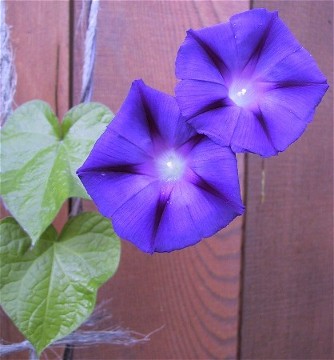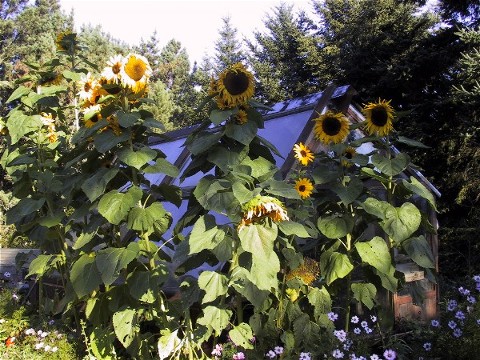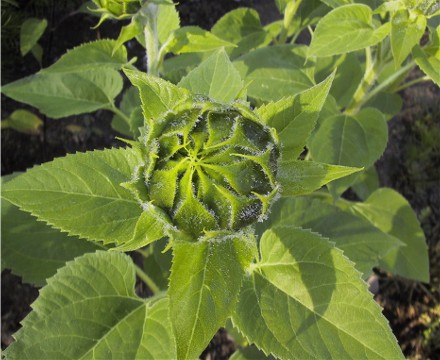

New Treasurer Takes Up Duties: Meet Wink Franklin, who replaces Rosemarie Hocker. Wink is a recent full-time Sea Rancher, though he and wife Laura Franklin have been here for ten years. Laura has been a stalwart Gardener for years. He is new to gardening, and entranced by the way the Posh Squash, a community garden unique among community gardens, works. He is retiring from 20 years with the Institute of Noetic Sciences in Petaluma.
Doris Buck Memorial Trellis: Ben Klagenberg is starting construction. If you want to help build it, let Ben know. Treasurer Wink Franklin reminds us that we still need about $150. Contributions are invited.
Winter Work Party, Wednesday, October 15, 2003: Jim Grenwelge and Ralph Rasmussen will lead the planning. Main work is to retire and mulch beds, clean up, and build over-winter compost heaps. Work starts at 9:30. Further planning and potluck details to follow.
Harvest Dinner, Wednesday, November 5, 2003: Mark the date. A great way to wind up the growing season and welcome the winter in a feasty ceremony rich in echoes across the ages from the beginnings of agriculture.
Garlic: Formerly a work party chore, Posh Squash’s famous, fabulous garlic crop will be planted by day crews this year. Peter Farmer is the Garlic Guru.
Ravens: Corvus corax appears to be working the ripening tomatoes in row 25 -- half- eatens here and there. Could be raccoons, but they are fastidious eaters, and kind of chomp away like a person. Ravaged remains bear suspicious, scooped grooves, as if a strong, long beak had been at work. Nah, couldn’t be a Gardener noshing away on the vine-ripened stuff…?

What does this portend? Starbucks apparently has a program to give away packages of spent coffee grounds, free. At a Santa Rosa Starbucks, Shirley Hulse (Tuesdays) spotted a binful of packages. She brought one to the Garden and passed it on to Chester Compost. “Wow,” he said, “Hitt [author of "A Gospel According to the Earth"; see below ] hit the target.” "FREE FOR YOUR GARDEN," the label on the sleek, silvery plastic, vacuum-packed bag read, "Used Coffee Grounds." Also an upbeat homily: “Coffee grounds are a nutritional additive for your soil. During the brewing process most of the acidity is removed, leaving used grounds with an average ph of 6.9 and a carbon-nitrogen ration of 2-1.” And helpful, easy-to-follow instructions for use. Chester likes to think vestigal residues of caffeine give his worm friends a buzz. He rushed to Bin 1 and rent the fastening label. From the bag several pounds of finely-ground, dried grounds spilled eagerly, as if destined, into the compost bin. Later, Chester visited the website noted on the label, www.starbucks.com/aboutus/compost.asp. Kind of like visiting a shrine. Several links led temptingly away to heavy duty composters' sites. The implications are boggling, if only they are tenable: What are there, a gazillion Starbucks all over the world, now processing and recycling their used grounds for FREE? Imagine a slow avalanche of brown grounds sliding back into the earth, elemental traces of soils from all over the tropical world devolving into soils all over the world, including the Posh Squash. Starbucks’ wizard bean-counters must have done the numbers and concluded, "this costs something, but pays off more." Or maybe it's an act of pure eco-faith? Hey, who’s to cavil. Way to go, Starbucks!

The Steering Committee met Friday, September 12, 2003, under the cherry tree. Present were Tom Warnock, Mary Austin, Sal Skibbins, Jer Skibbins, Dianne Rasmussen, Ralph Rasmussen, Wink Franklin, MA Brauer, and your faithful scribe, Chester Case.
Our new Treasurer Wink Franklin was introduced. He reported a balance of $4600. A large water bill is coming due, and $500 is in the Doris Buck Memorial Trellis Fund.
Tom brought the Committee up to date on the negotiations with the Baker Estate for the acquisition of the Garden site. Apparently they are talking it over. Tom thinks maybe a counteroffer is in the offing. He also brought up the boysenberries, which need attention if they are to produce. John Haws will be asked for a plan. Also, Tom asked for ideas to improve the aesthetics of the south fence, a sagging, rusty, not altogether deer-proof, ancient wire-mesh relic.
Yes, there will be a Winter Garden. Hardy souls should contact Dianne Rasmussen to get involved. About 10-12 beds will be planted to brassicas, lettuces and the like. Work will be on one day of the week, weather permitting. Incidentally, a visit to the Garden in wintertime is invigorating and treats you with an interesting contrast to the Garden in its summertime glory.
Speaking of Winter, time to winterize the Garden. Mainly, to retire and mulch some 44 beds, plus cleanup and putting away. Woodchips will not be used for mulch. Green manure cover crops, like low-growing fava beans, will be planted in some rows. A thick layer of straw over a thin layer of newspaper will mulch others. If frost kills the fava beans (as happened last year to one bed), straw will be laid down. Why mulch? To improve the soil, control weeds, protect the soil. About last year’s experiment with kelp: good amendment, not a good mulch, great addition to the compost. Anyone have a lead on good, cheap straw? Ken, Jim and Ralph are on the lookout.
The raised beds added this year worked out well. A terrific carrot crop in one, and kohlrabi in another. The Committee decided to build two more now, and add several each year. Recycled or salvage lumber is desired. With a raised bed, we can build the soil and enlarge the effective planting area.
In response to the think piece Tom distributed on organization and operations of the Garden, several Gardeners chipped in their ideas. Chester extended and expanded Tom’s thoughts in an organizational plan, which Tom distributed. Why codify? Why formalize? The Garden works as it is, but its future is uncertain, with difficult processes to navigate and tasks to accomplish ahead. The Posh Squash will need the advantage of a clear, compact and transparent instrument to tell what it is, what it stands for, how it is set up and operates. Gardeners will join the dialogue when the Committee has a discussion draft worked out. Gardeners interested in this kind of work are invited to get involved.
Dianne Rasmussen announced that the flower plantings at the heads of the beds will be discontinued.
For details or further information, talk to your Day Leader, or to Tom Warnock or Mary Austin.

Last month TCH introduced you to the kohlrabi and, lo and behold, the abundant crop in Bed 98 literally flew out of the ground. Now, ta da, here’s the tomatillo ((tohm-ah-tee-oh), that solanum what wears its own overcoat. Or which resembles a tiny paper lantern. Tomatillos count as relatives, near and distant, the eggplant, potato, tomato, and gooseberry. They grow well at the Garden. After an incredibly abundant crop several years ago that went largely unharvested, a smaller planting was laid in Bed 70 where the viney plants sprawl, prolific but steadily harvested by clued-in Gardeners.
Sharon Tyler Herbst has this to say about tomatillos in The New Food Lovers Companion: This fruit, which is also called Mexican Green Tomato, belongs to the same nightshade family as the tomato. In fact it resembes a small green tomato in size, shape and appearance except for the fact that it has a thin parchmentlike covering. The papery husk is a clue to the fact that the tomatillo is also related to the cape gooseberry. Although tomatillos can ripen to yellow they are generally used while still green and quite firm. Their flavor has hints of lemon, apple and herbs. Tomatillos are available sporadically year round in specialty produce stores, Latin American markets and some supermarkets. Choose firm fruit with dry, tight-fitting husks. [Editor’s note: You need to know that our tomatillos' husks are a little loose, but that’s all right.] Store in paper in the refrigerator for up to a month. Remove husks and wash before using. Cooking enhances the tomatillo’s flavor and softens its thick skin. Tomatillos are popular in Mexican and Southwest cooking for a variety of dishes including guacamole and many sauces. They can be used raw in salads and salsas. For a more acidic taste, canned tomatillos are available in ethnic markets. Tomatillos are rich in Vitamin A and contain a good amount of Vitamin C. The tomatillo is also called jamberry.
Alice Waters has a recipe for Black Bean and Roasted Tomatillo Soup in Chez Panisse Vegetables, p. 37. It is too long to include here, but here is Waters’ recipe for Salsa Cruda (p. 21), featuring our friend: Peel the papery outer skin off some tomatillos and reduce them to a puree in a mortar or a food processor. Add cubed avocado flesh, a little onion chopped into small dice, and a splash of water, if needed, to keep the consistency on the thin side. Season to taste with salt, a little fresh serrano chili pepper diced very fine, and cilantro leaves, if you wish. An excellent sauce with grilled vegetables, squash tamales, corn tortillas, or vegetable fritters.
Let your Day Leader or Ken Holmes know if you have a craving for more tomatillos next year.

Maria Bardini-Perkins has gathered some elegant recipes using sorrel. All were demonstrated at The Apple Farm in Philo By Sally Schmitt and her daughter Karen Bates. The Sorrel Sorbet and Sorrel Sauce for Salmon were creations of Sally and/or Karen. The Sorrel & Onion Panade was a Judy Rogers recipe, and the Chick Peas with Sorrel was a Nigella Lawson recipe. According to Maria, the sorrel sorbet can be served as a palate cleanser between courses, but with the cream it really becomes a dessert, albeit one people may have to develop a taste for.
Sorrel Sauce for Salmon
In a blender, make a puree by adding:
2 cups packed sorrel leaves
To:
1/2 cup melted butter
Fold into
2 cups mayo (beaten smooth)
Thin with
salmon's juices, until sauce is pourable
Serve salmon on a swirl of sauce, topped with a chiffonade of
sorrel leaves.
Sorrel & Onion Panade
6-8 servings
Sauté gently until starting to brown:
6 cups sweet yellow onions, thinly sliced
1/4 cup of olive oil
Add:
6 cloves garlic, sliced
salt
Continue cooking until onions are very tender.
Toss together
8-10 cups day-old chewy bread (remove crust, cut in 1"
cubes)
2 Tbsp. olive oil
1/2 cup chicken stock (or water)
salt & black pepper
Have ready:
2 generous handfuls sorrel leaves
6 oz (2 cups) grated Gruyere or Fontina
3 and 3/4 cups chicken stock, salted.
Layer together the onions, bread, sorrel and cheese.
You should have 2-3 layers of each.
Pour stock around the edges.
Bring to a boil on top of the stove, then cover with parchment
and foil and bake at 300 for 1 1/2 hours.
Uncover, turn heat up to brown top if necessary.
This works in an earthenware pot or deep skillet.
Chick Peas with Sorrel
Sauté in 2 Tbsp. olive oil:
1 small chopped onion
2 finely sliced garlic cloves
A pinch of dried cumin
Crumble over 1/2 dried red pepper
Sprinkle with salt
Cook for five minutes
Shred or chop 2 good handfuls of sorrel and add to pan
Then add:
2 cups drained, cooked chick peas (or 1 can)
Stir until chickpeas are warm. Serve in a bowl with more olive
oil drizzled
over it.
Sorrel Sorbet (requires an ice cream maker)
Make a simple syrup by boiling together:
1 cup sugar
2 cups water
Chill, then blend together in a blender:
simple syrup
2 cups packed sorrel leaves (no stems)
Add:
1 1/2 cups light cream or half & half
2 Tbsp. lemon juice (may need more, taste as you go)
Freeze.
Makes 4 cups
The colder the mix the better and the smoother.

Webmistress Reva has added a couple of pages of photographs to the Posh Squash website: Some photos taken by Bill Lange of the Posh Squash "hike" on August 2nd, and photos by Reva and by Ken Holmes taken during our work party the previous week.

Nasturtium was once accounted an extremely rare and elegant plant. It took the Old World by storm when it was brought back by early explorers. Its generic name Tropaeolum means "trophy," which evolved from an old legend that the plant grew from the blood of a dying Trojan warrior. From The Meaning of Herbs: Myth, Language & Lore, by Gretchen Scoble & Ann Field, Chronicle Books, 2001.

TCH told you in the last issue that Jack Hitt’s powerful essay, “A Gospel According to the Earth: sown by science, a new eco-faith takes root,” admirably reviewed by Sue Blair, was in the Atlantic, July 2003. Well, TCH was wrong: it is in Harper’s Magazine. Did get the date right, though.